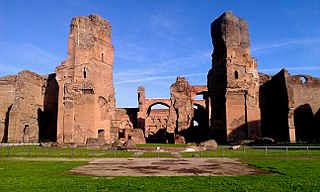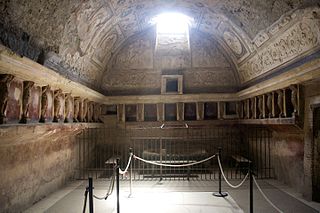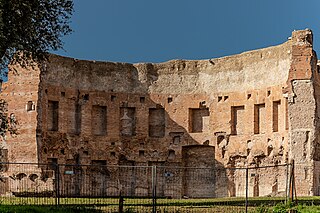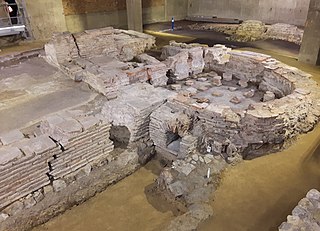
Ankara, historically known as Ancyra and Angora, is the capital of Turkey. Located in the central part of Anatolia, the city has a population of 4.5 million in its urban centre and over 5.6

In ancient Rome, thermae and balneae were facilities for bathing. Thermae usually refers to the large imperial bath complexes, while balneae were smaller-scale facilities, public or private, that existed in great numbers throughout Rome.

The Baths of Caracalla in Rome, Italy, were the city's second largest Roman public baths, or thermae, likely built between AD 212 and 216/217, during the reigns of emperors Septimius Severus and Caracalla. They were in operation until the 530s and then fell into disuse and ruin.

The Baths of Diocletian were public baths in ancient Rome, in what is now Italy. Named after emperor Diocletian and built from 298 AD to 306 AD, they were the largest of the imperial baths. The project was originally commissioned by Maximian upon his return to Rome in the autumn of 298 and was continued after his and Diocletian's abdication under Constantius, father of Constantine.

The Baths of Titus or Thermae Titi were public baths (Thermae) built in 81 AD at Rome, by Roman emperor Titus. The baths sat at the base of the Esquiline Hill, an area of parkland and luxury estates which had been taken over by Nero for his Golden House or Domus Aurea. Titus' baths were built in haste, possibly by converting an existing or partly built bathing complex belonging to the reviled Domus Aurea. They were not particularly extensive, and the much larger Baths of Trajan were built immediately adjacent to them at the start of the next century.

The tepidarium was the warm (tepidus) bathroom of the Roman baths heated by a hypocaust or underfloor heating system. The speciality of a tepidarium is the pleasant feeling of constant radiant heat which directly affects the human body from the walls and floor.

The Baths of Trajan were a massive thermae, a bathing and leisure complex, built in ancient Rome starting from 104 AD and dedicated during the Kalends of July in 109. Commissioned by Emperor Trajan, the complex of baths occupied space on the southern side of the Oppian Hill on the outskirts of what was then the main developed area of the city, although still inside the boundary of the Servian Wall. The architect of the complex is said to be Apollodorus of Damascus. The baths were being utilized mainly as a recreational and social center by Roman citizens, both men and women, as late as the early 5th century. The complex seems to have been deserted soon afterwards as a cemetery dated to the 5th century has been found in front of the northeastern exedra. The baths were thus no longer in use at the time of the siege of Rome by the Ostrogoths in 537; with the destruction of the Roman aqueducts, all thermae were abandoned, as was the whole of the now-waterless Mons Oppius. Early Christian writers misnamed the remains the 'Baths of Domitian'.

A frigidarium is a large cold pool at the Roman baths. When entering the bath house, one would go through the apodyterium, where they would store their clothes. After the caldarium and the tepidarium, which used hot water to open the pores of the skin, the frigidarium would be reached. The cold water would close the pores opened by the hot water. There would be a small pool of cold water or sometimes a large swimming pool. The water could be also kept cold by using snow.

Tlos is an ancient ruined Lycian hilltop citadel near the resort town of Fethiye in the Mugla Province of southern Turkey, some 4 kilometres northwest of Saklikent Gorge. Tlos is believed to be one of the most important religious Lycian sites and settlement on the site is said to have begun more than 4,000 years ago.

The Museum of Anatolian Civilizations is located on the south side of Ankara Castle in the Atpazarı area in Ankara, Turkey. It consists of the old Ottoman Mahmut Paşa bazaar storage building, and the Kurşunlu Han. Because of Atatürk's desire to establish a Hittite museum, the buildings were bought upon the suggestion of Hamit Zübeyir Koşay, who was then Culture Minister, to the National Education Minister, Saffet Arıkan. After the remodelling and repairs were completed (1938–1968), the building was opened to the public as the Ankara Archaeological Museum.
The history of Ankara can be traced back to the Bronze Age Hatti civilization, which was succeeded in the 2nd millennium BC by the Hittites, in the 10th century BC by the Phrygians, and later by the Lydians, Persians, Macedonians, Galatians, Romans, Byzantines, Seljuks, and Ottomans.

Alacahöyük or Alaca Höyük is the site of a Neolithic and Hittite settlement and is an important archaeological site. It is situated in Alaca, Çorum Province, Turkey, northeast of Boğazkale, where the ancient capital city Hattusa of the Hittite Empire was situated. Its Hittite name is unknown: connections with Arinna, Tawiniya, and Zippalanda have all been suggested.

Bathing played a major part in ancient Roman culture and society. It was one of the most common daily activities in Roman culture and was practiced across a wide variety of social classes.

The Welwyn Roman Baths are a Roman ruin preserved under the A1(M) just north of modern-day Welwyn Garden City, Hertfordshire, England. The baths were a small part of the Dicket Mead villa, which was originally built in the 3rd century AD.

Capo di Bove is an archaeological site on the Appian Way on the outskirts of Rome, Italy. It contains the thermal baths of a vast property owned in the 2nd century AD by Herodes Atticus and his wife Annia Regilla.

Billingsgate Roman House and Baths is an archaeological site in Londinium. The best preserved parts of the house are a bath with hypocausts. The ruins were discovered in 1848 while the Coal Exchange was built on the site. The remains were preserved and were visible in the cellar of the building. In 1967 to 1970, the Coal Exchange was replaced by another building and the Lower Thames Street was enlarged. Further excavations were made at the site and the remains were incorporated into the cellar of the new building, but were not open to the public.

The Roman Thermae are a complex of Ancient Roman baths (thermae) in the Black Sea port city of Varna in northeastern Bulgaria. The Roman Thermae are situated in the southeastern part of the modern city, which under the Roman Empire was known as Odessus. The baths were constructed in the late 2nd century AD and rank as the fourth-largest preserved Roman thermae in Europe and the largest in the Balkans.

The Baths of Nero or Baths of Alexander were a complex of ancient Roman baths on the Campus Martius in Rome, built by Nero in either 62 or 64 and rebuilt by Alexander Severus in 227 or 229. It stood between the Pantheon and the Stadium of Domitian and were listed among the most notable buildings in the city by Roman authors and became a much-frequented venue. These thermae were the second large public baths built in Rome, after the Baths of Agrippa, and it was probably the first "imperial-type" complex of baths, with a monumental scale and symmetrical, axially-planned design. While in the sixteenth century the foundations of the caldarium were still visible, nothing else of the structure remains above ground except some fragments of walls incorporated into the structure of Palazzo Madama.

Niğde Archaeological Museum is located in the centre of the Turkish provincial capital, Niğde between Dışarı Cami Sokak and Öğretmenler Caddesi. It contains objects found at sites in the surrounding area, including the tell of Köşk Höyük and the Graeco-Roman city of Tyana, both in the nearby town of Kemerhisar.

The Roman Bath is a public house in St Sampson's Square, in the city of York, in England. It is built above an ancient Roman bath house. The remains were uncovered during building work when the present pub was erected in 1929-31 replacing an inn. The exterior has Tudor Revival features including applied half-timbering. The pub is however more notable for the Roman remains which can be viewed inside.































